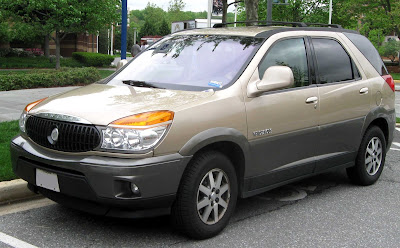I wonder if the clumsy camp of Buick's ads for their all-new 2018 Enclave was intentional. I hope so because from their sheer pretentiousness to their arrogance and presumptuousness, they're so off putting they're actually quite entertaining. The shame is that the marvelous pieces of engineering and design they're supposed to be selling are all but lost in a sea of nonsensical, urban angst we haven't seen on screen since the "The Truman Show". Then again, that's taking these ads seriously as they almost rudely make fun of the people they're targeting. Camp is one steep, slippery subjective slope. Are these ads effective at selling $50,000 minivans to moms? Apparently so given how these things are flying out of Buick dealerships. However, guys, please don't call the Buick Enclave an SUV. Why? Because it is not an SUV.
An SUV, or sport utility vehicle like the Chevrolet Tahoe, is a light truck based contraption. The Buick Enclave, however, is based on GM's Epsilon platform which in addition to underpinning similar vehicles like the GMC Acadia and Chevrolet Traverse, is also the foundation for such modern, robust and mundane sedans like the Chevrolet Impala, Buick Lacrosse and Cadillac XTS. Therefore, the Buick Enclave is a CUV - aka crossover utility vehicle or simply, "crossover". It is not, again, an SUV.
Why does General Motors hawk the Buick Enclave as an SUV? For starters, most people don't refer to their crossovers as such. Also, saying the Enclave is an SUV is far sexier than calling it a CUV or crossover. Why's that? Who knows. Some things just are. And if you look at whom the ads are targeting, you'll see that these ads are attempting to hit the bulls eye of the heart of today's mom. Let's make that millennial moms for certain these ads featuring slim, impeccably dressed, attractive young women in gorgeous suburban settings with beautiful kids, dogs and handsome husbands, sorry, partners, are also targeting young women who aspire to be moms.
Technically, the first cross over was the 1980 AMC Eagle but that was more of a 4X4 truck chassis with a car body bolted down on top of it. Officially, the first cross over was Toyota's 1994 RAV4. Based on the then current Toyota Corolla, the RAV4 combined the elevated seating position of a small truck with car like handling. Brilliant. On the luxury front, Mercedes Benz, of all manufacturers, stunned the world with their ML series in 1997; Lexus following suit a year later with their game changing Camry based RX300. Just like that, families started ditching the Town and Country and Voyager for vehicles they didn't even know they needed. General Motors, no surprise, was extremely slow to react and what they came out with at first was laughable.
Buick's first foray into the murky, uncharted waters of luxury crossovers was almost as bad as the vehicle it shared its underpinnings with, the Pontiac Aztek. Based on GM's second generation minivan platform, the Rendezvous combined the luxurious accoutrements of their range topping Park Avenue with an uncommon amount of versatility and practicality - Rendezvous could swallow a 4X8 sheet of plywood. Despite proportions akin to an AMC Pacer, Buick sold approximately 75,000 Rendezvous' a year between 2002 and 2007. In a fragmented marketplace that amounted to a paramount success. Many of those sales were no doubt due to steep discounting undercutting tonier makes and models but you can't argue with their success no matter how homely I think the Rendezvous was.
Buick (and GM) got serious about cross overs in 2008 when they rolled out the first Enclave. Sharing the same running gear as the GMC Acadia, Chevrolet Traverse and let's not forget the Saturn Outlook (the what?), the Lambda sourced Enclave, which is the foundation for the Buick Lacrosse sedan, was a vast improvement in ride, handling and, subjectively and most importantly, styling. Whereas the Buick Rendezvous could be construed as a vehicle Grandad and Grandma would get to haul their gaggle of grand children around in, the Enclave was seen by moms, first and foremost, as a vehicle that they could sheppard their brood in while not seeming out of place at the country club and the executive parking lot. Buick built the first Enclave en masse through 2017.
Fast forward to 2018 and all of a sudden Buick is touting the new Enclave as an "SUV". Very interesting. What with minivans putting a fork in station wagons, SUV's putting a fork in minivans and cross overs doing the same to SUV's, Buick is going to milk the ever cool and hip acronym "SUV" for everything they can. Even if it makes as much sense as calling the Enclave a station wagon. Which, in the end, is what it is. Just don't call it an SUV.
















































